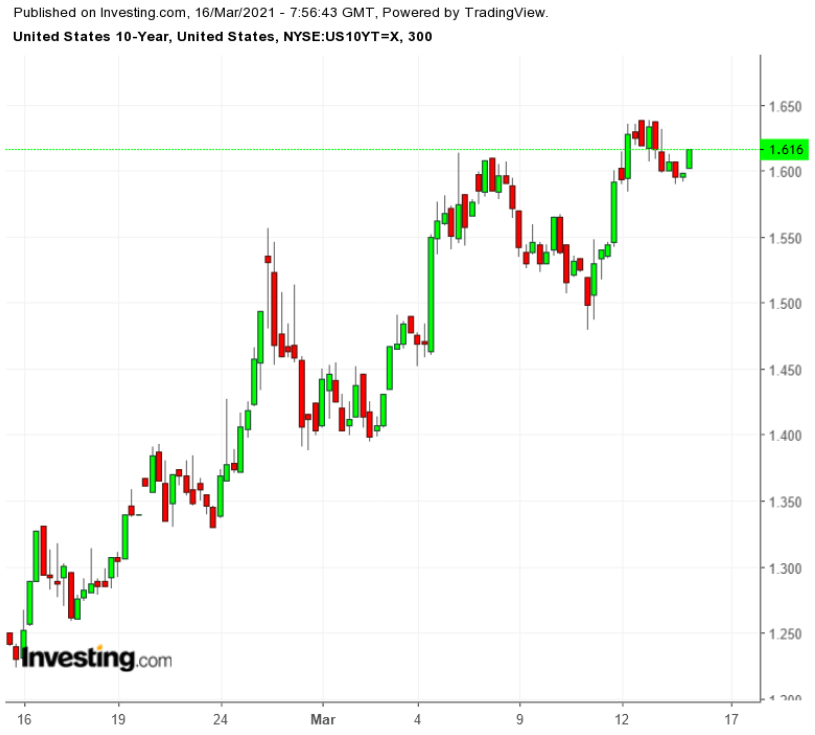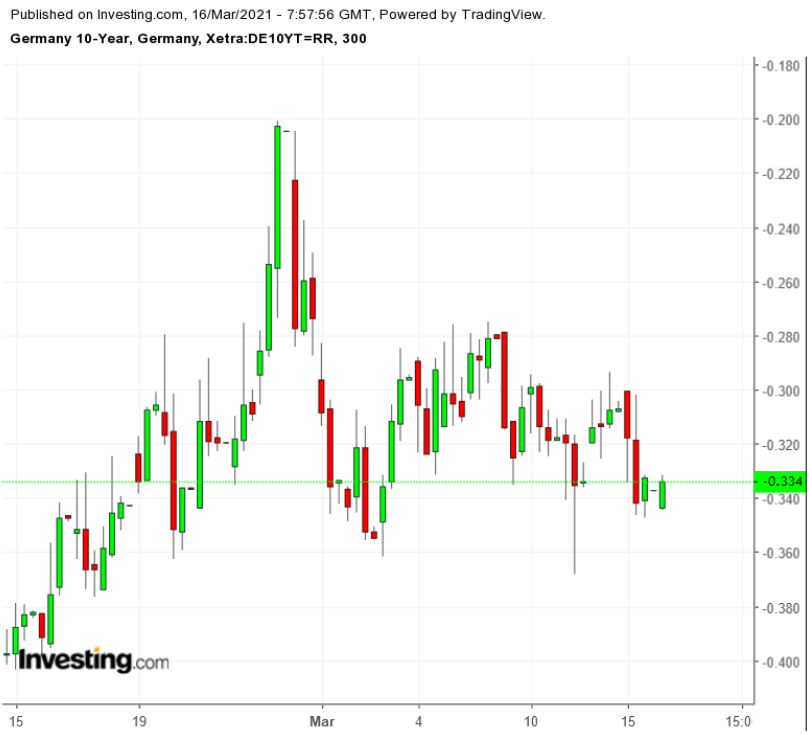Yields on the benchmark 10-year Treasury note remained above 1.6% on Monday ahead of the Federal Reserve policy meeting Tuesday and Wednesday, as more analysts look for the pivotal yield to hit 2%.

Meanwhile, eurozone government bond yields declined, widening the gap with Treasury yields as the disconnect between Europe and the U.S. grows.
Recovery Optimism Translating To Higher Treasury Yields
The European Central Bank’s announcement last week that it will increase its emergency bond purchases “significantly” to curb rising yields seems to be working, or at least helping.
Data disclosed on Monday indicated that the ECB boosted its pandemic bond buys to €14 billion in the week before the policy decision, from €11.9 billion the previous week. ECB executive board member Isabel Schnabel, who is head of market operations, hastened to warn market participants that technical reasons can account for weekly variations and they shouldn’t over-interpret the data.
Nonetheless, yields on Germany’s 10-year bonds, which are a benchmark for the euro area, declined to below minus 0.33% Monday, about 3 basis points lower than on Friday. Italy’s 10-year yield declined about 3 bps from Friday, dipping below 0.60%, compared to above 0.65% before Thursday’s announcement from the ECB and above 0.76% at the beginning of the week.
The economic outlook in the U.S. is brighter in many respects than that in Europe. Washington has engineered a $1.9 trillion stimulus with payments to individuals starting this week along with expanded unemployment benefits, which together should boost consumer spending.
But that optimism about economic recovery is translating into higher Treasury yields, which could ripple across the economy and slow growth.
Stocks remained strong on Monday as the Dow Jones Industrial Average hit its fourth straight record high on Monday amid reports that stimulus money would find its way into the stock market. The broader S&P 500 also rose and the NASDAQ, with a tech stock concentration, recovered from its Friday decline into a correction.
But if the Fed maintains its stance that rising bond yields are not a concern, that could spur investors to test the central bank’s resolve by selling more bonds and pushing up the yield (bond yields move inversely to prices).
Europe, meanwhile, is being roiled by a second wave of COVID infections and a pause in using the AstraZeneca (NASDAQ:AZN) vaccine because of concerns about possible links to blood clots. Italy is re-imposing lockdowns amid a spike in infections.
Even Germany, often so efficient, has botched the vaccine rollout and voters took out their frustration with the government by handing the ruling Christian Democrats their lowest postwar scores in two state elections Sunday. A scandal involving Christian Democrat lawmakers getting kickbacks for facilitating procurement contracts for protective mask makers didn’t help.

All this has sent euro-area investors scrambling for the safe haven of government bonds as uncertainty clouds the outlook.
The U.S. is hardly out of the woods. While bond yields reflect concerns about inflation and point to higher interest rates, reports of tax increases to pay for further government spending plans are starting to leak out. Corporations and high earners would bear the brunt of these increases, with reports that the Biden administration may raise the corporate income tax rate from 21% to 28%.
And then there’s the Fed. If members of the Federal Open Market Committee fail to adjust their forecasts in the Summary of Economic Projections to show higher growth and higher inflation—and perhaps an increase in short-term rates before the end of 2023—they may lose credibility and sap investor confidence.
